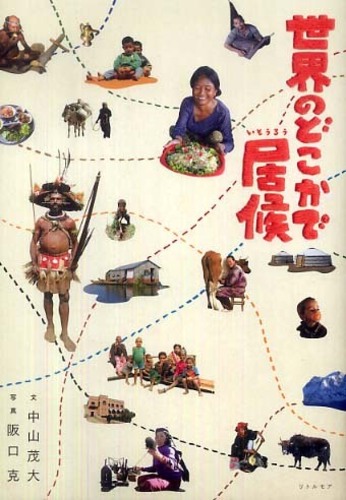世界のどこかで居候 by 中山茂and 坂口克 (人力社)「Sekai no Dokokade Isourou」by Shigeo Nakayama and Katsumi Sakaguchi (Jinrikisha)
“Isourou” – a difficult word to translate in English. I went through a number of dictionaries searching for a word that would closely describe the form of travel that that author Shigeo Nakayama and cameraman Katsumi Sakaguchi created. I also checked with a few online dictionaries and most of them gave the same answer – “to lodge” or “lodging” which is close to what the two were doing but not exactly. A closer approximation would be “home stay”, but “home stay” usually applies to students and these two are far beyond their university years. One online dictionary gave the exact definition of what they were doing – “lodger who pays nothing for room and board”, but the other definitions that followed were “freeloader” and “sponger”. So the closest translation of the book title would be Lodging for Free Somewhere Around the World.
Four years! Eight countries! Nakayama and Sakaguchi traveled around the world between the years 2004 and 2008. They set a standard rule for lodging with strangers. They would stay for no more than a week. They would not schedule their trip to coincide with any events or festivals, and they would not ask for anything in return, only for the families to live their everyday lives as if they weren’t there. They would sleep in the same rooms, eat the same foods, and work in the fields with their hosts. And there would be no guide or interpreters during their stay.
Choosing how long they would stay with each family was another factor they had to decide before leaving. In Nakayama’s own words, “if the stay is too short, it wouldn’t be considered lodging. If the stay is too long, we would be wearing out our welcome.” One week seemed perfect. As Nakayama also says, “the first day you would be considered honored guests. The second day, the children would start to get used to you, by the third day, it would make no difference if you were there or not”. It was Nakayama and Sakaguchi’s goal to reach this point, at which time they believed that the families would start telling them their true thoughts, feelings, and desires.
Nakayama says every country seems to have a distinct smell. For example, Korea has the smell of kimchee. France has the smell of cheese. Thailand has the smell of fish sauce. Egypt has the smell of antique books. For Mongolia, Nakayama says that the country’s odor is of feet! And this is the first country where their “lodging for free” experiment would start. The first family they lodged with were nomads living in a yurt on the great plains two hours away by jeep from the capitol of Ulan Bator. A few years before, the Mongolian government had given this family the ownership and responsibility for watching over one hundred head of livestock. The family was well-known in the area for being one of the few that included a yak in their herd. As to the reference of “smelling like feet”, Nakayama says it came from the various homes airing out their socks that most families wear for a week or more. In Mongolia, it is the custom to build a new yurt for newlyweds, and during their weeklong stay, Nakayama and Sakaguchi would help build one for the son of their host family who had recently gotten married.
The next country where they “lodged without paying for room or board” was on the Saudi peninsula of Yemen. The first thing they learned about this country is that there is no true government. Of course there is a central government based in the capital of Sana’a, but its main purpose seems to be dealing with foreign affairs. Yemen is a tribal country and an Islamic society. It took Nakayama and Sakaguchi a little while to get used to the qat- chewing(similar to the coca leaf of South America but the qat is legal in Yemen), Kalishnikov- carrying men, who also were equipped with a jambiya (dagger with a short curved blade).
Following Yemen, the pair lodged with tribesmen in Papua New Guinea, stayed with a family in Ladakh, in the state of Kashmir in India, spent a week in the Atlas Mountains and another week lodging with a family living in the Sahara Desert in Morocco. They also lived with a family whose home was in one of the floating villages of the Tonle Sap lake in Cambodia. The final country where they became lodgers was in Nepal, at Galegaon, a community known for its village tourism and adventure trekking.
Sakaguchi’s full color pictures, along with Nakayama’s illustrations of the various homes around the world that sheltered these travelers make this one entertaining book. They give us a peek at what ordinary life is like in some of the most unlikely places. Overcoming language barriers, eating unfamiliar foods, they give us a small glimpse into how diverse the cultures of our world really are. The pair discovered that people are alike everywhere. All whom they stayed with welcomed their guests as family once they became accustomed to the novelty of having strangers lodge in their homes, which I think says a great thing about humanity. by Ernie Hoyt
(This book is only available in Japanese.)
